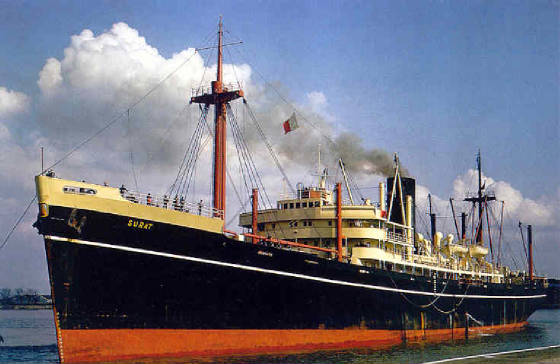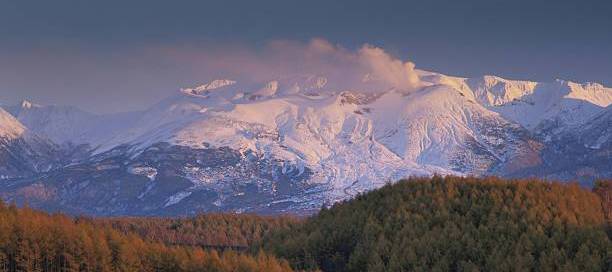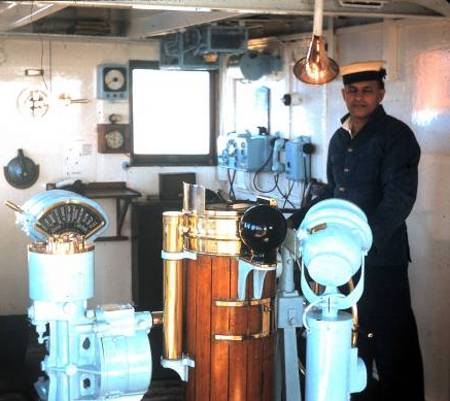



As Second Officer of the ss Surat, back in 1967, I was struck by her speed, compared to similar ships of her size and class. John Foot summed it up perfectly in his excellent book, ‘The Illustrated Diary of a Thames Pilot.’
23rd January 1964 ~At 0500, on passage from Yokohama, the Company's ss Surat was approaching the island of Hokkaido.
'The southeast corner of the island appeared on the radar, and a good fix obtained from Erimo Saki Point, twenty-eight miles distant. P&O’s Surat was six miles east of her DR - Dead Reckoning - and course was altered accordingly, direct for Kushiro some one-hundred nautical miles away.

A beautiful mid-winter morning dawned, flat calm, and as the sun rose from the sea it illuminated the snow-clad Tokachi mountains to the north, vivid white against the deep blue beyond. The ship gradually came to life. The Serang and his men busied themselves preparing hatches for loading at Kushiro, in particular Number 3 Hatch, which had been cooled down in readiness for the large consignment of frozen cuttlefish.

The seacunnies changed at the wheel, ‘Do tali panch, sahib,’ and my Goanese steward arrived on the bridge with my morning tea and toast, the highlight of the morning watch. In those days, the Chief and Second Officer shared a steward, while the Captain had one to himself. Shortly before eight bells, Captain Freddie Irons came up to the bridge and was immediately impressed by the beauty of the mountain range, which was gradually taking shape on our port bow. Always eager to take a closer look, he ordered ‘Steer North, let’s take some photographs.’ With that, he left the bridge on his way to breakfast. By 0935, we had closed to two miles off the coast and were running parallel to it, along the ten fathom bank. We were due at Kushiro at noon, time in hand, and the scenery was breathtaking. Most of the passengers were out on the boat deck, well wrapped up against the sub-zero temperature, admiring the view. At 1000, it was ‘Board of Trade Sports’, or, more correctly, General Emergency Stations. The ship’s whistle blasted, alarm bells rang, and the crew ran to their posts. Fire hoses were run out, asbestos suits and helmets donned, fire doors and watertight doors tested. Life jackets on, boats swung out and lowered to the embarkation deck. The usual routine, but not easy to fit in when in and out of port almost every day, as opposed to the ample time available on an ocean passage. By 1030, the ‘Emergency’ was over and the crew resumed the preparation for arrival, hoisting derricks on the foredeck, removing hatch securing bars, wedges and tarpaulins - jobs which would have been impossible had the weather been anything less than perfect. The ‘Emergency’ was over, but another, very real one lay directly in the ship’s path, only minutes away.
Note: The Serang was the Indian Crew’s Boatswain and the Seacunnies are the ship’s Indian Quartermasters, who steered the ship.
On the bridge, the Fourth Officer and his cadet were kept busy frequently plotting the ship’s position. The Captain leant over the bridge wing watching the scenery and the crew were busy on the foredeck. With Kushiro little more than an hour away, the Fourth Officer had several other duties to contend with - organising the flags, pilot ladder, the clearing away of the anchors, synchronising the clocks and warning the engine room. This was normal routine and, of course, his top priority was the safe navigation of the ship. At 1043, a fix by visual bearing and radar distance, put the ship inside the line and approaching a two fathom sounding. Under normal circumstances the Fourth Officer would have taken immediate action, but, with the Captain on the bridge, he chose to inform him first. The Captain walked into the chart room, looked at the chart, went back to the wheelhouse and ordered starboard helm. The delay was critical. Even as the ship’s head began to swing it was already too late. With a tremendous tearing crunch, Surat impaled herself upon a rocky shoal. From full sea speed to full stop in the space of seconds. It took several moments for the awful truth to sink in. Some thought there had been an explosion in the engine room. Others thought a derrick had fallen. But up on the bridge, the grim reality was clearly evident. For with the main engine still thrashing at full speed, the sea below was calm and still, no longer being thrust aside by the ship’s progress. Perhaps the calmest man onboard was Freddie Irons. He ordered ‘Stop’ on the engine room telegraph, told the Fourth Officer to fix the position on the chart and picked up the phone. ‘I am afraid we are aground Chief, but I want to run the engine at maximum revolutions ahead and then full astern if she’s not free.’
There were three decks from my cabin to the bridge, but I was up there in seconds, leaning over the bridge wing as the main engine built up to emergency full power. There was a tremendous vibration as she strained to break free but, after five minutes, it was decided that we might do more harm than good. ‘Stop engine.’ High water had been 0851 but in that part of the world, though there are strong currents, the range of the tide is small, about one metre. There was still a chance to escape, before the water dropped further, by changing the trim. But by now reports were coming up from the engine room, which was taking water, especially in the 150 ft long shaft tunnel. The watertight door to the tunnel was closed. Water ballast was pumped out of the aft tanks and the forward tanks filled to change the trim. The carpenter sounded the bilges, and soundings taken all round the ship to establish the terrain of the seabed. ‘I suppose we’ll have to inform London,’ said the Old Man. ‘Get hold of the Regulations and the Code Book, we don’t want everyone to know.’ Renewed efforts were made to wrest Surat from the rock shoal’s grip. But to no avail. We were going to need help, and the sooner the better, for the weather could change at any time. Mid winter, and it would need only a moderate swell to grind the bottom out of the ship. Contact was made with the Japanese Coastguard, who despatched a vessel from Kushiro. As calm as ever, the Captain requested the twelve passengers to assemble in their lounge. He regretted that they would be unable to continue their round trip in Surat. Instead they would be landed at a small fishing village nearby, and arrangements made for them to continue to either Yokohama or Kobe, thence to Hong Kong for a scheduled P&O passage to England. But the passengers were far more concerned for the Captain and expressed their sympathies for him. The grim reality of the situation was lightened somewhat in the afternoon when a small fishing boat arrived to land the passengers. Its decks were littered with large crabs, and it was hard to suppress a smile as Miss Peebles, the Royal Governess, and the others picked their way gingerly among their unwelcome shipmates, and sat on the thwarts with their feet tucked up under their chins. Soon afterwards, the Coastguard vessel arrived, together with salvage officials. Bad news travels fast. At the same time we lowered a lifeboat and took further soundings round the ship in the hope of finding an escape route into deeper water.
As the light faded there was little else that could be done. The passengers were ashore, and the ship and crew in no immediate danger. From within the ship the extent of the damage was impossible to establish. In fact, much of the hull from midships to the stern was severely ruptured. Had it not been for the double-bottom fuel tanks, and the closed watertight door to the shaft tunnel, the engine room would have flooded, and the ship settled more firmly agrou8nd, perhaps never to come off. It was an eerie sensation keeping watch on the bridge that first night. A low ground swell rolled Surat gently 5 degrees to port then 5 degrees to starboard, while far below, the steady grinding of steel against rock provided a constant reminder of our predicament. There were a few isolated lights from a nearby village to keep us company, whilst high above on the signal mast, three red lights denoted “Ship Aground”. At first light salvage tugs arrived, and work began in earnest to lay out anchors ahead of the ship. On the foredeck, all the powerful winches were disconnected from their cargo runners and topping lifts. Massive blocks and tackles were laid out on the deck and shackled to the anchor wires. The preparations were to take three days. Meanwhile, tenders for the lucrative repair work were being received from Yokohama, Kobe and Hakodate shipyards. The latter yard was firm favourite being so much nearer, until it was realised that the drydock was ten feet too short. ‘No problem’, replied Hakodate, ‘we shall cut a V in the dock tomorrow.’ Another arrival that day was the P&O Superintendent from London. His unenviable brief to establish the cause, take statements, and sign up the repair yard. A sense of shock pervaded Surat. We just could not accept that this beautiful thoroughbred should be rendered helpless and seriously injured. She was our home, had been for months, and we had no thoughts of deserting her now. We’d see it through together. Perhaps we would have thought differently had the weather deteriorated, but it remained calm throughout, and only the low ground swell to remind us of nature’s placid mood. There was little else to do but wait. Some wrote letters, and we all discussed at length the ‘hows’ and ‘whys’. A very worried agent arrived from Kushiro. There was a thousand tons of cuttlefish waiting at his port, and now he had no ship in which to load it. But at least he had brought our mail, and he promised to post ours upon his return ashore. There was plenty to write about.
For such a tragedy to happen at all, what better place than off the coast of Japan. In recent years Japan has rapidly overtaken Germany and the UK as the leading shipbuilding nation in the world, and if anyone could refloat and repair Surat in record time, it could only be the Japanese.. The salvage crew worked through the day and night laying out the ground tackle 2,000 metres ahead of the ship. Then, as midday and high water approached, the foreman stood on the focsle holding aloft two numbered discs ‘5 and 6’. Slowly two large cargo winches picked up the slack of the wire tackle. Then it was ‘3 and 4’, followed by ‘1 and 2’. Gradually adjustments were made to the tensions of each winch, so that each bore an even strain. Then it was the turn of the salvage tug to tighten her tow wire. At exactly 12 o’clock, right on prediction, the foreman, as if conducting an orchestra, raised all six discs, the tug brought to full power, and without a murmur, Surat started to glide forward. No time was lost in slipping the ground tackle, and once the ship had been towed into deeper water, the engine was tested and found to be usable despite vibration and the shaft bearings being immersed in sea water. Course was set for the few remaining miles to Kushiro, where a more detailed survey could be made before the 200 mile passage to Hakodate. By now our plight had caught the imagination of the Japanese press and television, who crowded on board as soon as we were berthed. With no-one able to speak English, there was no necessity for our ‘No comments’. Fortunately there was little concern about pollution for, although many fuel tanks were ruptured, the oils was trapped by the pressure of the water and could only be released once in dry-dock. On the other hand, with the fuel-pipe suctions positioned at the bottom of each tank, it would be impossible to feed uncontaminated fuel to the boilers unless there was one tank watertight. And so it proved. Of the six tanks, number two starboard, containing 153 tons was more than sufficient for the next stage. Only a superficial survey was possible in Kushiro, and the full extent of the damage could only be ascertained in dry-dock, so we limped on to Hakodate, bearings running hot in sea water, with tug escort, only to be delayed there for two days with deteriorating weather making it impossible to enter the dry-dock. At last we were secured in the dock and, as the water level fell, massive wooden posts were wedged in at frequent intervals between the dock walls and the ship’s sides. Lower sank the water until it reached the chocks upon which Surat rested, four feet above the dock floor. Only now could the full extent of the damage be appreciated.
The ship’s hitherto flat bottom was now horribly corrugated and distorted, and a hundred fractures seeped oil, made glutinous in the sub-zero temperatures. Dockyard workers laboured in the awful conditions, hammering wedges in the attempt to stem the flow. The keel plate, almost an inch thick, as if torpedoed, had a gaping hole 6ft by 4ft under the shaft tunnel, and filled with rock, crabs and fish. By now, the dry-dock had been pumped clear of water and only oil remained. With temperatures 20 degrees below freezing, the task of clearing up the fuel oil was greatly hampered, and the gangs laboured night and day, scooping it up into forty-gallon drums. Over 600 tons were collected in this manner and each change of shift saw blackened figures, covered from head to toe in oil, climbing the steep steps from the bowels of the dry-dock. The teams of Japanese workers worked round the clock for two days in acute discomfort and considerable danger, as slowly, grudgingly, the ruptured tanks disgorged the thick, treacly oil. Then began the unsavoury task of cleaning up the floor of the dock before the repair and cutting equipment could be lowered down. Everywhere and everything was covered in black slime, and the first jobs on board were to sand the teak decks, lay paper along the internal alleyways and cabins, and to roll up all carpets out of harm’s way. Fortunately, under the circumstances, life went on very much as usual for we were able to use our own generator to provide light, heat and cooking facilities.
The P&O Company instructed the Captain to return to London and the remainder were to stand by the ship until repairs were complete. Faced with the prospect of six week’s inactivity, the Nippon Salvage Company more than played their part in keeping us occupied. Each morning a van arrived, complete with ski equipment, to drive those who were off duty to the slopes of Hakodate Yama, and there most of us were introduced to the sport for the first time There were three cinemas in Hakkodate which regularly showed recent English-speaking films, but these did no prove as popular as the numerous bars and nightclubs…….Meanwhile, repairs were on schedule. Large sections of the bottom plating had been cut away together with the contorted steel frames and double-bottom tanks. The propeller removed and repaired, and the propeller shaft re-aligned. At the end of the sixth week, the last of over fifty new steel plates, each measuring some 20ft by 6ft, had been welded into position. After trials, under the command of her new Captain, Roger Cutler, Surat loaded a full cargo of cased motorcycles and made her fastest ever passage to London in twenty-one days at an average speed of nineteen knots.'